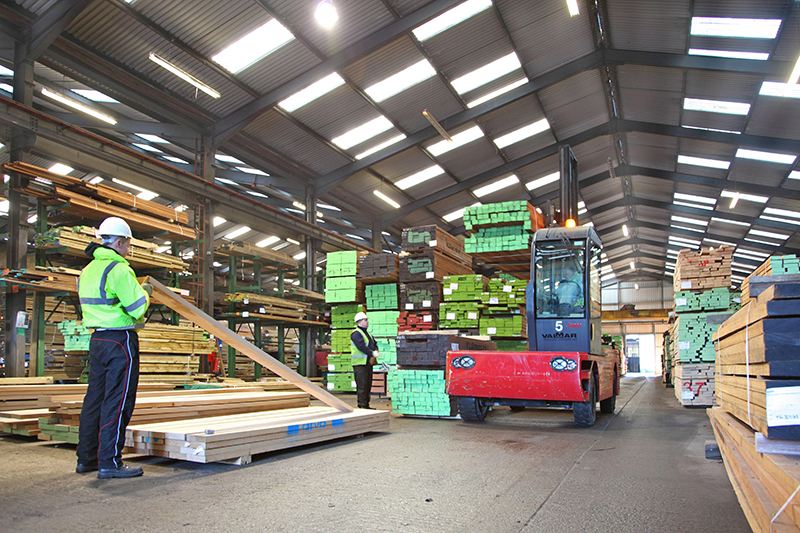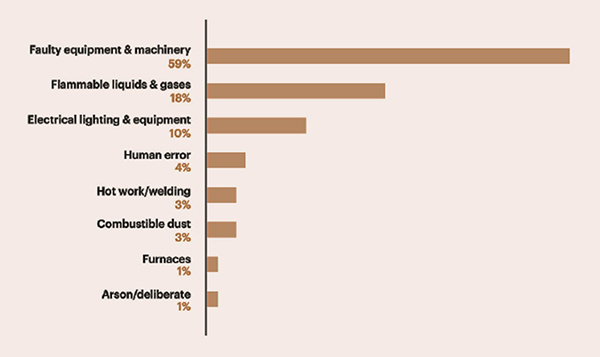Hunter Seymour examines the issue of factory and industrial fires – with four incidents having taken place across one week in January alone. What is the context behind this growing problem? Why might new risk assessments be urgently required? And, how can fire professionals better protect premises from becoming another casualty to arson?
Remarkably, in the space of one week this January, four serious factory fires were reported in England, with three of these industrial sites listed as ‘disused’ or ‘derelict’. A sobering trend indeed, it would seem.
There has also been a rise in fires in the ‘Industrial Premises’ category according to the latest UK recorded figures. Meanwhile, the most recent trends for England and Wales reveal arson and criminal damage rose by 13% in the post-pandemic period recorded last year.
These outcomes are compounded by the exposure of industrial assets to a range of new potential fire hazards, extending from the impact of the Energy Crisis on factory shutdowns, decline in production with workforce layoffs, to the shortage of skilled labour and reduced preventive maintenance.
On a global scale, according to Resilinc Supply Chain Risk Management, of all the disruptive events tracked worldwide by the company’s ‘EventWatch’ 24/7 global event monitoring service, factory fires are consistently the number one disruption to supply chain resilience. For risk management professionals, then, this changing threat demands commitment to renewed vigilant appraisal.
Causal pathways to factory fires
To avert supply chain disruption, it is crucial to reassess current uncertainties in the manufacturing and supply chain industries and to focus on specific solutions to mitigate future risks.

Bindiya Vakil, CEO, Resilinc
Bindiya Vakil, CEO of Resilinc, sums up many of the challenges:
“In 2022, we reported the highest number of factory fires ever recorded with an 85% jump over 2021, and this number just continues to climb. The biggest driver we see is gaps in regulatory and process execution, as well as a shortage of skilled labour in warehouses, with Covid having exacerbated the issue. Component shortages and adverse weather conditions like extreme heat also play a role.”
The Resilinc White Paper on Factory Fires further summarises the causal pathways leading to many of the problems of workplace disruption. Primary causes of fires include: electrical and lighting installations; human error; faulty equipment and machinery; flammable liquids and gases; arson; furnaces; and hot work/welding.
The Report concluded that, where fires had started in the assembly or manufacturing area, 9% of fires led to over four weeks of downtime. Often, equipment and machinery are not properly installed, operated, or maintained, which can lead to industrial fires. Companies do not always have proper safety, cleaning, or maintenance routines for machinery, and often employees aren’t sufficiently trained.
What’s more, companies typically do not proactively replace older equipment or machinery. Instead, they wait until the equipment stops functioning properly, which can be a significant fire hazard.
“Why so many factory fires?”
The bottom-line conclusion is answered by Bindiya: “Because people are not doing the preventive maintenance. Factories need to be kept clean, free of debris near the hot work areas,” she says. “There needs to be constant inspection of the electrical systems and machinery and installations like that.”
In short, she reminds manufacturers that a return to best practice should be the key outcome from restoring routine levels of production after Covid.
A sector under pressure to transform
Underlying the pressures on manufacturers aiming to return to pre-Covid production levels, however, are fears of closures or factory shutdowns due to the impact of soaring energy costs. A new survey of more than 200 senior manufacturing industry bosses reveals that two-thirds expect to cut production or jobs as a result.
So, connected with this reluctant ‘hibernation’ of once active industrial premises, risk managers are likely to identify new fire hazards.
Consider, too, the shifting values of industrial sites in the context of an undersupplied UK housing market where investing in brownfield regeneration would have a transformative effect.

Image credit: Simon Turner/AlamyStock
Recent analysis by the CPRE (Council for the Preservation of Rural England) reveals that a record number of brownfield sites has been identified for redevelopment in England, which – lying dormant – could provide 1.2 million homes at a time of a nationwide housing crisis and calls for levelling up from deprived regions seeking affordable solutions. This year, the UK government announced there would be £60 million available to councils to revive brownfield sites and make way for high quality new homes.
It follows that derelict industrial premises have acquired a new status with property values for such assets being re-examined, as well as potential adjustments to classifications such as ‘Change of Use, with implications for revisions of fire risk assessments.
It also follows that such defunct industrial premises are of greater risk of arson, with insurance cover consequently requiring renewal.
Industrial premises under threat
With more than a £1 billion per annum paid out by insurers, according to the ABI (Association of British Insurers), fire is one of the most expensive categories of property insurance claims.
The majority of claims are genuine. However, property fraud is a significant and continuing problem for Insurers. ABI research shows that the value of dishonest property insurance claims has risen to £124million, up 9%. This increase was driven by a rise in the value of commercial frauds uncovered.
£2.5 billion penalty – Factory fires destroy businesses
The RRFSO (Regulatory Reform (Fire Safety) Order) guidance in “Fire Safety Risk Assessment for Factories and Warehouses” states: “The costs of a serious fire can be high and afterwards many businesses do not reopen… the costs as a consequence of fire, including property damage, human casualties and lost business, were estimated at £2.5 billion.”

Origins of factory fires 2020-21 (Credit: Resilinc whitepaper)
The Fire Order guidance reminds fire risk professionals: “If you have any reason to suspect that your fire risk assessment is no longer valid or there has been a significant change in your premises that has affected your fire precautions, you will need to review your assessment and if necessary, revise it. Reasons for review could include: Change of use…”
The review recommends attention to changes to work activities or the way that you organise them; alterations to the building, including the internal layout; and, critically, considerations of the type and number of people using the premises.
This advice for risk assessment is as applicable to industrial premises undergoing change due to increased production as it is to under-occupied factories facing reduced workforces.
For comprehensive “Step-by-Step Guidance” for fire risk assessment of industrial premises, the RRFSO checklist is essential:
- Identify fire hazards
- Identify people at risk
- Evaluate, remove, reduce and protect from risk
- Record, plan, inform, instruct and train
- Review

